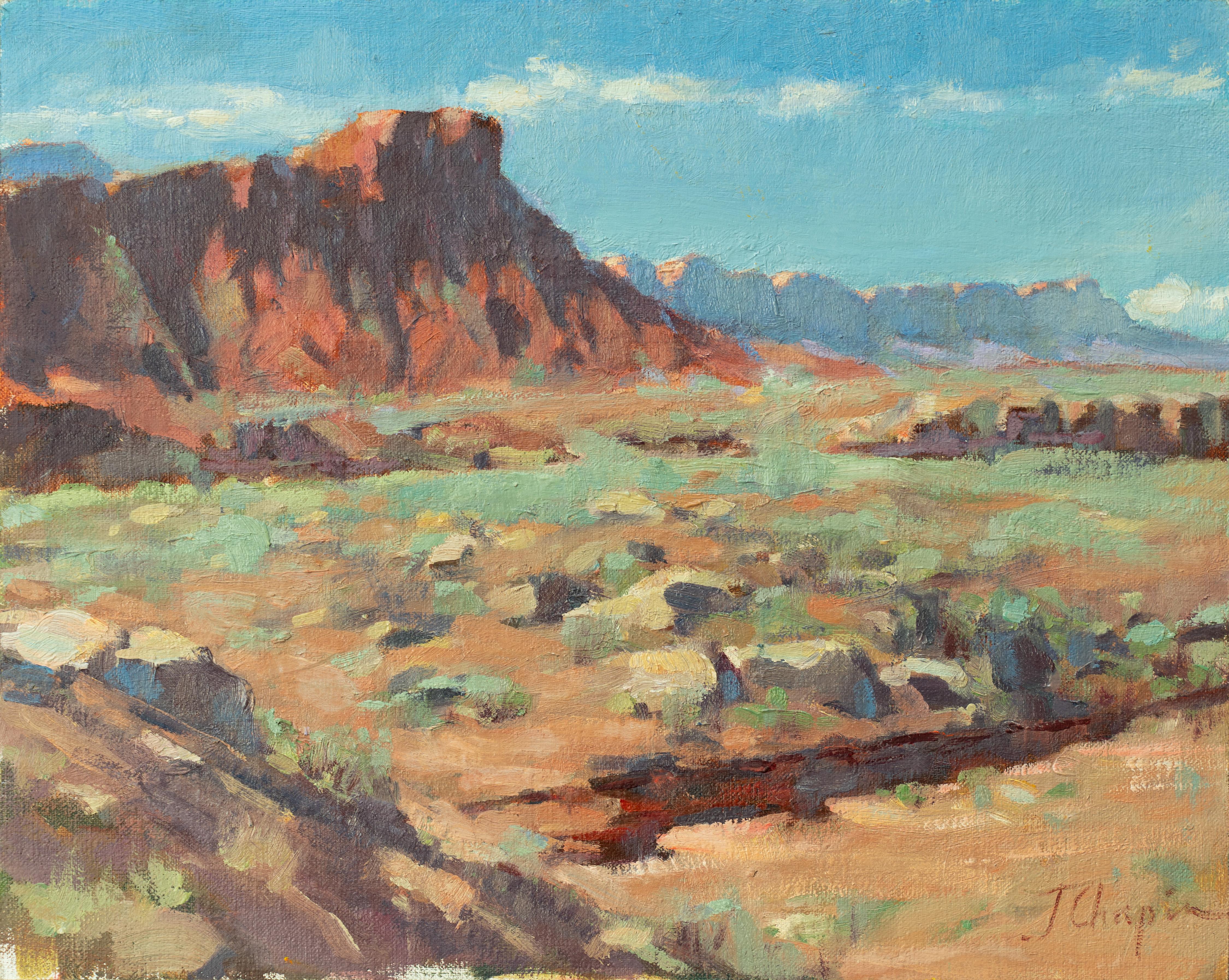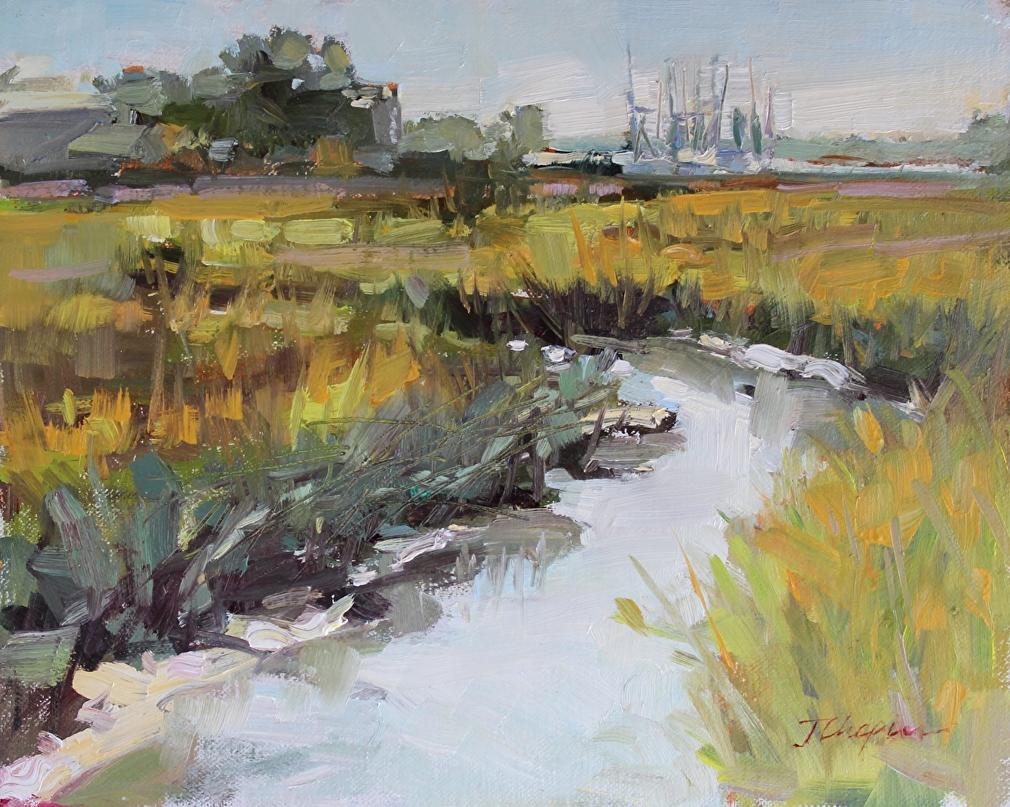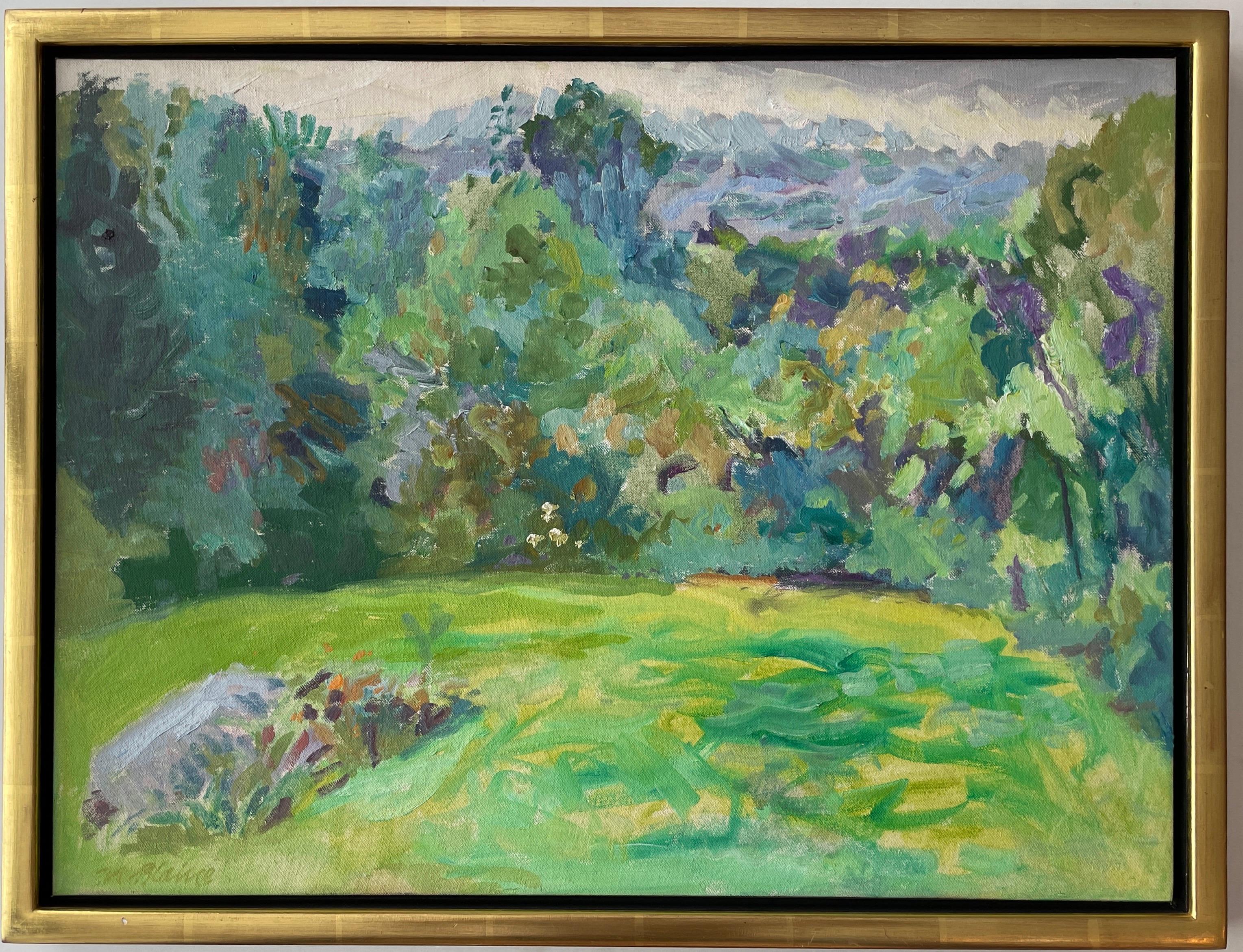Items Similar to "Central Park, Sherry Netherland Hotel, Plaza Hotel" Nathan Hoffman, New York
Want more images or videos?
Request additional images or videos from the seller
1 of 7
Nathan Hoffman"Central Park, Sherry Netherland Hotel, Plaza Hotel" Nathan Hoffman, New York1970
1970
About the Item
Nathan Hoffman
Central Park, Sherry Netherland Hotel, and Plaza Hotel, 1970
Signed, dated, titled on the reverse
Oil on artists board
10 x 16 inches
Born in Russia, the son of Friede (1878 – 1956) and Benjamin Hoffman (1878 – a. 1942). Benjamin was a dealer in mineral and seltzer water and the family resided on Snediker Avenue in Brooklyn, New York, just down the streetfrom the home where George Gershwin (1898 – 1937) was born.
This area of Brooklyn, known as Brownsville, “witnessed the development of one of the largest communities of Eastern European Jewish immigrants during the last decade of the 19th century and the first two decades of the 20 th century.” Today, little remains of this once thriving Jewish section of Brooklyn, which today houses many commercial and repair businesses.
Hoffman studied at the Art Students League of New York, the National Academy of Design and in the art program at Cooper Union. His work at the National Academy received praise, and in 1921 he was awarded the 2nd prize and an honorable mention from the John Armstrong Chaloner Paris Prize Foundation at the National Academy, which allowed the recipient to study in Paris, France for as long as five years. The following year he was awarded the 1 st prize in the competition (with The Reform Advocate running the headline “Young Jew Wins Art Prize”) as well as the Suydam Bronze Medal for his achievements in the Academy’s Men’s Night Class. In 1923 he was residing in Long Branch, New Jersey, when he was awarded 4th place in the Chaloner competition.
Early on, Hoffman exhibited his work throughout the city, including in 1925 with the recently organized Society of Independent Artists. He also received several solo exhibitions during the first part of his career, including one at Ferargil Galleries in 1929. In the spring of 1930 a solo exhibition of his portraits, including paintings and drawings, was held at at Babcock Galleries, where a reviewer noted: “Portraiture is obviously Mr. Hoffman’s specialty… his best work is characterized by a sensitive appreciation of character set down in a vigorous decisive statement.
Later that same year, in August, he participated in Babcock’s summer exhibition where reviewer Jerome Klein, writing for The Baltimore Sun, felt Hoffman’s and other artists work was already becoming old fashioned, remarking “…if an effort toward accomplishment is to be made, it must be in the language of today. It is for that reason that such contemporaries as Eugene Higgins and Nathan Hoffman, in this show, seem artists of a bygone era…” The onset of the Great Depression appears to have slowed his success, as was the case for many up-and-coming artists.
By 1939 Hoffman had become a gallerist in addition to being a painter, operating the collective exhibition space “Sutton Gallery,” which was originally located at 358 East 57th Street. There Hoffman exhibited his own works as well as those created by other prominent New York artists including David Burliuk (1882 – 1967), Charles C. Curran (1861 – 1942), Louis Eilshemius (1864 – 1941), Ann Goldthwaite (1869 – 1944), Maurice Kish (1895 – 1987), Lawrence Lebduska (1894 – 1966), Bradford Perin and Ellis Wilson (1899 – 1977), among others.
Hoffman continued to exhibit his and other artist’s works at the gallery through at least 1963, by which time it had moved to 236 East 60th Street. That year he held a spring exhibition which was dominated by early 20 th century artists, including Charles W. Hawthorne (1872 – 1930) and Joseph Stella (1877 – 1946). Among the works he personally exhibited in the show was a portrait he painted of National Academician, Alphaeus P. Cole (1876 – 1988). Even with his own retail space, Hoffman continued to exhibit elsewhere in the city, including at The Jewish Club and at the Washington Square Artist’s Fair.
Nathan Hoffman died in Flushing, Queens, New York on Sunday, the 20 th of May 1979 at the age of seventy-nine years. At present it is not known where his service was held, however he was interred at New Montefiore Cemetery in West Babylon, New York. An alternate birth date of April 23, 1900 was noted on his World War I registration card, however nearly all other documents record as his birth occurring in February, indicating the April date is likely an error.
Most of what is known about Hoffman is through the several groupings of figurative, landscape and seascape paintings that have appeared on the market over the years. He seems to have been particularly interested in painting in Brooklyn at Brighton Beach, Coney Island and elsewhere in the environs of New York City. Many of these works are small in size, indicating many of them were painted en-plein-air. His earlier works are impressionist in style, though during his later years some abstractions do appear. Hoffman signs his name fully on his paintings as “Nathan Hoffman” and they are often signed and fully dated on the verso as well.
Though there are undoubtedly other exhibitions in which Hoffman participated, those presently known include the following: Society of Independent Artists, New York, NY, 1925; Ferargil Galleries, New York, NY, 1929 (solo); Babcock Galleries, New York, NY, 1930 (twice, spring solo & summer group exhibition); National Academy of Design, New York, NY, 1931; Allied Art Festival Exhibition, Spring Lake, NJ, 1935; Sutton Gallery, New York, NY, 1939 – 63 (solos & group shows); Podell Art Exhibition, New York, NY, 1939; The Jewish Club, New York, NY, 1945? (solo); Kettler Group Exhibition, New York, NY, 1953; Washington Square Artists Fair, New York, NY, (u.d.).
Hoffman’s works are not presently known to be in the collection of any public institutions, however his works reside in many private collections throughout the United States.
- Creator:Nathan Hoffman (1900 - 1979, American)
- Creation Year:1970
- Dimensions:Height: 17.25 in (43.82 cm)Width: 23 in (58.42 cm)
- Medium:
- Movement & Style:
- Period:
- Condition:
- Gallery Location:New York, NY
- Reference Number:1stDibs: LU1841212878202
About the Seller
5.0
Platinum Seller
These expertly vetted sellers are 1stDibs' most experienced sellers and are rated highest by our customers.
Established in 2021
1stDibs seller since 2022
60 sales on 1stDibs
Typical response time: 1 hour
- ShippingRetrieving quote...Ships From: New York, NY
- Return PolicyA return for this item may be initiated within 3 days of delivery.
More From This SellerView All
- "Locomotive Train in Snowstorm, " Guy Wiggins, American Impressionist, WinterBy Guy WigginsLocated in New York, NYGuy C. Wiggins (1883 - 1962) Locomotive Train in Snowstorm, 1957 Oil on paperboard 8 x 10 inches Signed lower left; signed and dated on the reverse Guy Carleton Wiggins is best known for his impressionistic snow scenes of New York in 1920's. Wiggins lived in Old Lyme and Essex where he operated an art school. The Connecticut country-side was conducive to his impressionist technique of plein-air painting and broken brushwork. Ironically, although his work includes many fine Connecticut landscapes, he is best remembered for some snow scenes of New York City. Like many other American Impressionists, Wiggins had one foot in the city and the other in the country (Vermont Hillside, South Londonderry). Wiggins was born in Brooklyn, New York, went to England with his family as a boy, received an English grammar school education, and traveled widely abroad. He was the son of a prominent artist, Carleton Wiggins, a painter in the Barbizon style who studied with George Inness and admired Anton Mauve and Dwight Tryon...Category
1950s American Impressionist Landscape Paintings
MaterialsOil, Cardboard
- "The Green Parasol, " Henry Hannig, American Impressionist, Woman in Beach SceneBy Henry HannigLocated in New York, NYHenry Charles Hannig (1883 - 1948) The Green Parasol Oil on canvas mounted on board 6 x 7 3/4 inches Provenance: R.H. Love Galleries, Chicago, Illinois Private Collection, Lake Orion, Michigan Hannig, born in Hirschberg, Germany on 27 February 1883, came to America with his parents at the age of seven. He attended school in the southwest suburbs before the family settled in Chicago. Young Henry enrolled in the Chicago Academy of Fine Arts where Lawton Parker became his mentor. He made ends meet by working in industrial design and illustration. By 1908 he was a pupil in the School of the Art Institute of Chicago where students followed the traditional European drawing curriculum, beginning with the copying of master engravings and drawing after plaster casts, then concentrating on the nude figure. Students worked toward the goal of winning various academic prizes. One of Hannig's fellow students was Louis Ritman...Category
1910s American Impressionist Figurative Paintings
MaterialsCanvas, Oil, Board
- "Berkshires Winter Landscape, " Leo Blake, Snowy Stream in MassachusettsBy Leo BlakeLocated in New York, NYLeo B. Blake (1887 - 1976) Berkshires Winter landscape, Massachusetts, circa 1952-53 Oil on canvasboard 12 x 16 inches Signed lower right Provenance: Private Collection, Massachuset...Category
1950s American Impressionist Landscape Paintings
MaterialsOil, Board
- "Low Tide - Brittany, France, " Henriette Oberteuffer, Coastal LandscapeBy Henriette Amiard OberteufferLocated in New York, NYHenriette Amiard Oberteuffer (1878 - 1962) Low Tide - Brittany, France Oil on canvasboard 18 x 21 1/2 inches Signed lower right Painter, printmaker, and teacher Henriette Amiard Oberteuffer (1878-1962) was born in Le Havre, France and studied at the Academie Julian in Paris with Jean-Paul Laurens and Benjamin Constant. She moved with her husband and fellow artist George Oberteuffer...Category
Early 20th Century American Impressionist Landscape Paintings
MaterialsOil, Board
- "Haystacks on the Marsh, " Arthur Diehl, American Impressionism Sunset LandscapeLocated in New York, NYArthur Vidal Diehl (1870 - 1929) Haystacks on the Marsh at Sunset, 1927 Oil on board 14 x 22 inches Signed and dated lower right Born in England to...Category
1920s American Impressionist Landscape Paintings
MaterialsOil, Board
- "Autumn in New England, " Aldro Thompson Hibbard, Impressionist Marsh LandscapeBy Aldro Thompson HibbardLocated in New York, NYAldro Thompson Hibbard (1886 - 1972) Autumn in New England Oil on canvasboard 18 x 25 inches Signed lower right; estate stamped on the reverse Born in Falmouth, Massachusetts, Aldro Hibbard was an Impressionist landscape painter much concerned with light and shadow. He was one of the founders of the Rockport Art Colony, and the Rockport Art Association now occupies his former studio. Hibbard grew up in Dorchester and Boston and spent much time in the summers in Boston and Cape Cod. He showed early artistic talent, an interest he shared with a life-long love of baseball, which led to his becoming a professional baseball player. For his art training, he graduated from the Massachusetts Normal School and studied at the Boston Museum School with Edmund Tarbell...Category
Mid-20th Century American Impressionist Landscape Paintings
MaterialsOil, Board
You May Also Like
- Vermillion at Lee's Ferry ( Plein Air Landscape painting sky blue terracotta)By Jane ChapinLocated in Cody, WYThis is a 'Plein Air" landscape Painting by Jane Chapin as seen in the viewing room exhibition on Silas VON MORISSE GALLERY. “Plein-Air” is the French expression to describe the act of painting in situ within the landscape, capturing the ever changing weather and light with tonal qualities, colour, loose brushwork and softness of form... The practice of “Plein Air Painting” goes back for centuries but was truly made into an art form by the French Impressionists such as Claude Monet, Camille Pissarro, Alfred Sisley, and Pierre-Auguste Renoir who were advocating of plein air painting. Much of their work was done outdoors in the diffuse light of a large white umbrella. Another major proponent of Plein Air was Jean Baptiste Camille Corot whom Claude Monet considered as “The only One Master here”. Corot provides a transition from the sharp academic style that ruled in his day with focus on the natural world and the lyrical expressiveness of one's work. With her "Plein Air Paintings", Jane Chapin is part of one of the largest art movements in history. Her paintings carry human emotions. We can read her moods and feelings with places that carry deep remembrances for the artist that go beyond the descriptive. "My paintings grow from observing and interpretating light as it emerges from, surrounds and reflects on everyday people and scenes. They seek to remind us of the beauty of our common surroundings, regardless of where we are." - Jane Chapin Jane Chapin Painting the Land of the Free...Category
2010s American Impressionist Landscape Paintings
MaterialsLinen, Oil, Board
- Pecos Temple (Plein Air landscape Painting - beige neutral colors)By Jane ChapinLocated in Cody, WYThis is a 'Plein Air" landscape Painting by Jane Chapin as seen in the viewing room exhibition on Silas VON MORISSE GALLERY. “Plein-Air” is the French expression to describe the act...Category
2010s American Impressionist Landscape Paintings
MaterialsLinen, Oil, Board
- Coming In & Going Out ( Plein Air Landscape painting green yellow colors)By Jane ChapinLocated in Cody, WYThis is a 'Plein Air" landscape Painting by Jane Chapin as seen in the viewing room exhibition on Silas VON MORISSE GALLERY. “Plein-Air” is the French expression to describe the act of painting in situ within the landscape, capturing the ever changing weather and light with tonal qualities, colour, loose brushwork and softness of form... The practice of “Plein Air Painting” goes back for centuries but was truly made into an art form by the French Impressionists such as Claude Monet, Camille Pissarro, Alfred Sisley, and Pierre-Auguste Renoir who were advocating of plein air painting. Much of their work was done outdoors in the diffuse light of a large white umbrella. Another major proponent of Plein Air was Jean Baptiste Camille Corot whom Claude Monet considered as “The only One Master here”. Corot provides a transition from the sharp academic style that ruled in his day with focus on the natural world and the lyrical expressiveness of one's work. With her "Plein Air Paintings", Jane Chapin is part of one of the largest art movements in history. Her paintings carry human emotions. We can read her moods and feelings with places that carry deep remembrances for the artist that go beyond the descriptive. "My paintings grow from observing and interpretating light as it emerges from, surrounds and reflects on everyday people and scenes. They seek to remind us of the beauty of our common surroundings, regardless of where we are." - Jane Chapin Jane Chapin Painting the Land of the Free...Category
2010s American Impressionist Landscape Paintings
MaterialsLinen, Oil, Board
- Storm Over Assateague ( Plein Air Landscape painting light green yellow blues)By Jane ChapinLocated in Cody, WYThis is a 'Plein Air" landscape Painting by Jane Chapin as seen in the viewing room exhibition on Silas VON MORISSE GALLERY. “Plein-Air” is the French expression to describe the act...Category
2010s American Impressionist Landscape Paintings
MaterialsLinen, Oil, Board
- Summer, Quaker Hill oil painting by Nell BlaineBy Nell BlaineLocated in Hudson, NYThis work by Nell Blaine was exhibited at the Poindexter Gallery, as well as the Tibor de Nagy Gallery, both in New York City. It is signed lower left, and signed, titled, and dated ...Category
1960s American Impressionist Landscape Paintings
MaterialsOil, Board
- Oil Landscape of Cape Cod MassachusettsBy Aldro Thompson HibbardLocated in Fredericksburg, VAThis is a beautiful Cape Cod Massachusetts spring landscape with a rural farm and water behind it was painted by American artist Aldro Thompson Hibbard (1886-1972). Hibbard was born in Falmouth, Vermont and later became one of the founders of the Rockport Art Colony, living on Cape Ann in Massachusetts and summering in Jamaica, Vermont. Trained at the Boston Museum School, Hibbard carried forth the tenets of traditional academic art into the 20th century. He became very well-known for his New England...Category
Mid-20th Century American Impressionist Landscape Paintings
MaterialsOil, Board
Recently Viewed
View AllMore Ways To Browse
Seltzer Water Vintage
Vintage Plaza Hotel
Vintage Place Card
1939 New York Fair
Vintage National Park Art
Jewish Artists Paintings 19th Century
Vintage Paint Kettle
Vintage Mens Dior
Vintage National Park Signs
Frederick Lyman
George Washington Nicholson
J Ruiz
Leon Printemps
Oil Navy Attack
Otto Emerson
Ruth Squibb
S Hotchkiss
Sotter Clouds




